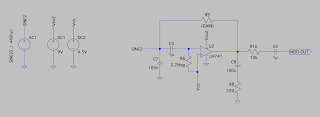This is a very unusual one - the Earth Sound Research Graphic Fuzz. Why is it so unusual - have a look at the schematic. It has no input or output caps, and the IC runs at +/- 4.5V. Practically half the parts on the board are for the split rail power supply.
Be careful with grounding connections as it's kind of unusual (see schematic), and it will behave weirdly on some settings, with oscillation etc., which is normal for this one.
Please note that this is a different circuit compared to the one on Guitar Effects Layouts - see the comparison down the bottom of this post. The one on Guitar FX layouts is based on a work-a-like, from what I gather, that someone posted in a forum to try and 'normalise' the design.
EARTH SOUND RESEARCH GRAPHIC FUZZ - VERO LAYOUT
SCHEMATIC
The schematic can be found in this thread on DIY Stompboxes. Look for the post from Goodrat, who was a former employee. Last post in March 2021 updated the schematic - nothing major, just added a 10k resistor at the output going to the volume control.
LTSPICE
There's little happening here - split rail power supply, opamp distortion, and some minimal filtering.
Comparing 50k to 1meg for the fuzz control (called filter on the pedal) - practically the same, leaving 950k of rotation on the pot wasted
This is from 1k to 50k - most of the action seems to happen in this range
I also tried the modded version on Guitar FX Layouts, and the traces look different - still a massive fuzz by the look of it, but even less range in the fuzz control.
This version is a far more regular-looking circuit, with coupling caps and a normal bias voltage.







10 comments:
HI! Im already builduing this pedal, but im confused with the first capacitor (the one on the left). Is it filling four holes, or three?
Hello. It spans row 2, to row 5. Good luck with the build.
Hey! I've never built a pedal with V- before. How does that work? Does it require an extra circuit or something? Any info would be appreciated. I've seen V- on other layouts but never really tried them out because I didn't understand how it works. Thanks!
Hello - No extra circuit required. There's still the regular ground, but with this the IC is running at +/- 4.5v. Usually when there's a negative supply there's an inverter involved to provide +/-9v. This splits 9v into halves. It's a fairly primitive circuit, expect some unruly behaviour.
Meant to reply to this shortly after you posted it but forgot about it! So is the V- on the layout just for reference? No wires go to it? I'm sure it's super easy to understand and I am over thinking it. I have built a couple other version of the HP but I think they had extra stuff tacked on. I figured I should give this one a shot as well and see if it makes a difference.
V- connects to the negative terminal of the power supply / battery. So yes it definitely connects to something. What is different here is that V- does not connect to ground.
I will give it a shot. I appreciate it!
Good luck - I haven’t even put this on a breadboard yet, so please let me know how you go
I am back! Tried it today. Fired up first try. I don't get any oscillation/squeals at all though - anywhere. And most of the filter sweep doesn't change anything. That kind of falls inline with some other versions I've built. It's crazy this one doesn't squeal at all and I didn't apply any tricks to get it to stop (no stacking chips, no buffer before - nothing). It also seems to get loud fast - could be my pot I suppose? I used the 741 from Tayda (UA741CP) if anyone else builds this and sees my comment down the road. Let me know if you got different results with a different version. I also used box caps if that makes a difference.
Thanks for posting this and replying to my comments Andy. I would've never tried it if you hadn't helped explain the +/- thing. I always just think of it as + and ground essentially but if it ever comes up again I will know how to tackle it.
Hey no problem at all, happy to help. The caps should not matter, and high output is as expected from what I saw on LTspice. Will have to build / breadboard one myself and update the post.
Post a Comment